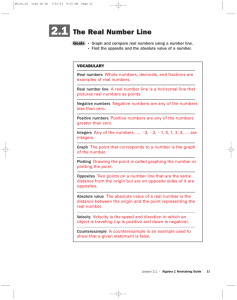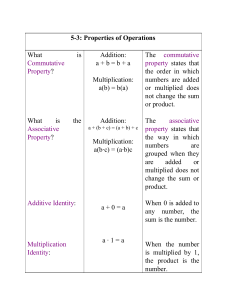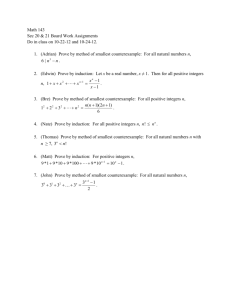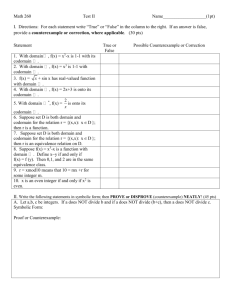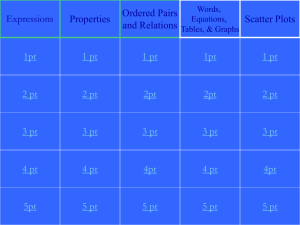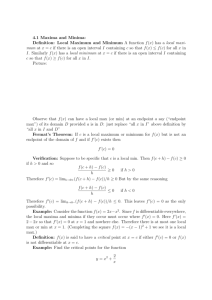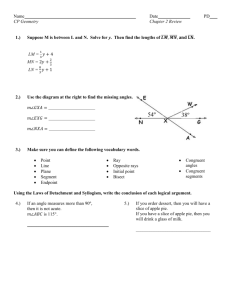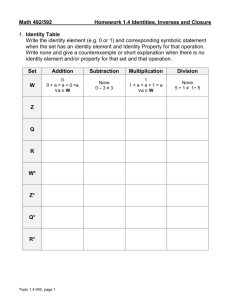Necessary & Sufficient Conditions
advertisement
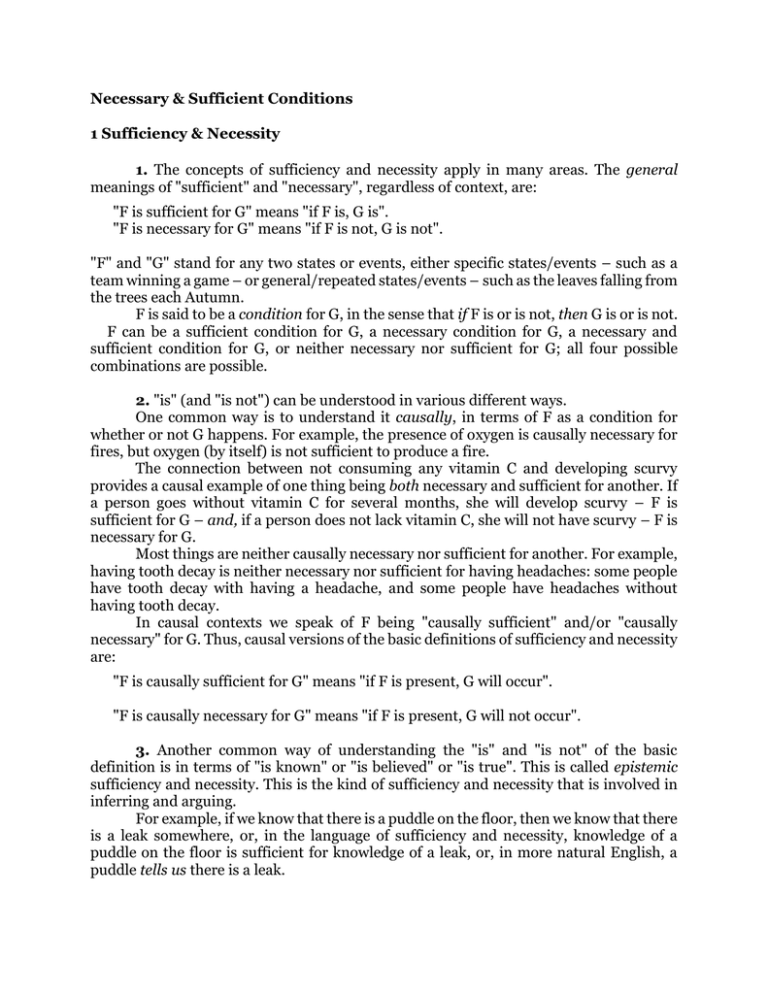
Necessary & Sufficient Conditions 1 Sufficiency & Necessity 1. The concepts of sufficiency and necessity apply in many areas. The general meanings of "sufficient" and "necessary", regardless of context, are: "F is sufficient for G" means "if F is, G is". "F is necessary for G" means "if F is not, G is not". "F" and "G" stand for any two states or events, either specific states/events – such as a team winning a game – or general/repeated states/events – such as the leaves falling from the trees each Autumn. F is said to be a condition for G, in the sense that if F is or is not, then G is or is not. F can be a sufficient condition for G, a necessary condition for G, a necessary and sufficient condition for G, or neither necessary nor sufficient for G; all four possible combinations are possible. 2. "is" (and "is not") can be understood in various different ways. One common way is to understand it causally, in terms of F as a condition for whether or not G happens. For example, the presence of oxygen is causally necessary for fires, but oxygen (by itself) is not sufficient to produce a fire. The connection between not consuming any vitamin C and developing scurvy provides a causal example of one thing being both necessary and sufficient for another. If a person goes without vitamin C for several months, she will develop scurvy – F is sufficient for G – and, if a person does not lack vitamin C, she will not have scurvy – F is necessary for G. Most things are neither causally necessary nor sufficient for another. For example, having tooth decay is neither necessary nor sufficient for having headaches: some people have tooth decay with having a headache, and some people have headaches without having tooth decay. In causal contexts we speak of F being "causally sufficient" and/or "causally necessary" for G. Thus, causal versions of the basic definitions of sufficiency and necessity are: "F is causally sufficient for G" means "if F is present, G will occur". "F is causally necessary for G" means "if F is present, G will not occur". 3. Another common way of understanding the "is" and "is not" of the basic definition is in terms of "is known" or "is believed" or "is true". This is called epistemic sufficiency and necessity. This is the kind of sufficiency and necessity that is involved in inferring and arguing. For example, if we know that there is a puddle on the floor, then we know that there is a leak somewhere, or, in the language of sufficiency and necessity, knowledge of a puddle on the floor is sufficient for knowledge of a leak, or, in more natural English, a puddle tells us there is a leak. Notice that epistemic sufficiency/necessity is different from causal sufficiency/necessity. Knowing that there is a puddle is sufficient for us to know that there is a leak, but the puddle is not the sufficient cause of the leak. 4. In the dictionary, in the context of the meanings of words, the definitions on offer are supposed to give a definition that is both necessary and sufficient for the word being defined. Consider the following faulty definition of "human": A human is (defined as) a tool-using animal. A good definition will provide a sufficient and necessary understanding. We can show that a proposed definition is not good by testing separately for sufficiency and necessity. First, is being a tool-using animal sufficient for being a human? That is, does tooluse reliably indicate a human being? No; apes are tool-using animals, but are not humans. Second, is tool-use necessary for being a human? That is, does non-tool-use mean a non-human? Again, no; a baby does not use tools but is still a human. This definition fails on both counts; being a tool-using animal is neither sufficient nor necessary for being a human. 5. The following piece of the tax code provides an example of what we might call "legal" or "conventional" sufficiency and necessity: A tax credit for energy-efficient home improvement is available at 30% of the cost, up to $1,500 total, in 2009 & 2010, ONLY for existing homes, NOT new construction, that are your "principal residence" for Windows and Doors (including sliding glass doors, garage doors, storm doors and storm windows), Insulation, Roofs (Metal and Asphalt), HVAC: Central Air Conditioners, Air Source Heat Pumps, Furnaces and Boilers, Water Heaters: Gas, Oil, & Propane Water Heaters, Electric Heat Pump Water Heaters, Biomass Stoves. This rule can be understood as saying that making one of the improvements listed to your existing home is a legally sufficient condition for taking the tax credit, and also a legally necessary one. That is, if you make one of the listed improvements, you can legally take the credit. It also informs you that if you do not make one of the listed improvements, you do cannot legally take the credit. Or in other words, it is necessary to meet these criteria in order to take the credit. A 'conventional' example familiar to students is that passing a certain number of courses is necessary but not sufficient for graduation. 6. Compositional or part-whole relationships can be understood in terms of necessary and sufficient conditions. The proposition "No bee lacks wings." can be understood as "Having wings is a necessary condition for being a bee." and "All dogs have tails." as "Being a dog is sufficient for having a tail." and "Not every robin is red." as "Being red is not necessary for being a robin.". We might call this "constitutional" sufficiency and necessity. 7. Now for something somewhat tricky (and not needed in order to do the exercises, but which simplifies things): using "non-states", we can rewrite necessity in terms of sufficiency. So far in this section we have taken F and G to be positively described states or events, such as the occurrence of a storm or eating a certain food, which are then either present or absent. Causal sufficiency then involves presence-presence pairs (e.g. if there is lightning, there is thunder), and causal necessity involves absence-absence pairs (e.g. if you don't pass the exam, you don't pass the course). But the absence of F and the absence of G can be thought of as the presence of nonF and non-G. By talking about non-F and non-G, we can build the "does not occur" part into the states/events. Up above, we said that "F is causally necessary for G" can be expressed as "If F does not occur then G does not occur.". We can now rewrite this as "If non-F occurs then non-G occurs." or in brief "Non-F is sufficient for non-G.". So, for "causally sufficient" and "causally necessary" we get F is causally sufficient for G and non-F is causally sufficient for non-G. 8. You can probably see that it is possible to have examples that mix together states and non-states. In other words, F might be sufficient for non-G or non-F sufficient for G. One familiar causal example of a F and non-G relationship is the relationship being vaccinated and contracting the disease. When children are vaccinated (i.e. vaccination is present) the disease is not contracted (i.e. the disease remains absent). We can express this relationship by saying that the presence of vaccination (F) is causally sufficient for the absence of the disease (non-G). In this way, we can get rid of the idea of necessity and just use sufficiency along with the positive or negative descriptions of the states or events. Here are causal examples of the four possible combinations: (1) F is sufficient for G e.g. a wind-speed of 120 mph is sufficient to destroy brick buildings (2) non-F is sufficient for G e.g. not having working brakes results in crashes (3) F is sufficient for non-G e.g. vaccination is sufficient for avoiding the disease (4) non-F is sufficient for non-G (= "F is necessary for G") e.g. lack of water kills plants We have now expressed all four combinations of positive and negative states using sufficiency as the relationship between them. All four relationships could alternatively be expressed in terms of necessity, in the sense of "prevents". For example, the relationship between vaccination and disease can be expressed as "The absence of a vaccination is necessary for the presence of the disease.". The overall lesson here is that you can think entirely in terms of sufficiency so long as you are very clear about what the two types of thing in the relationship are. Exercises Good definitions provide necessary and sufficient conditions. For each of the following suggested definitions, say whether or not the definition on offer provides (i) a necessary condition, (ii) a sufficient condition, for what is being defined, and, (iii) in each case where you give a negative answer, provide a counterexample as an illustration. Sample A chair: a four-legged seat. Necessary Condition: Yes No Counterexample: A wheelchair is a chair but has no legs. Sufficient Condition: Yes No Counterexample: A couch is a four-legged seat but not a chair. 1. A human: a tool-using animal. Necessary Condition: Yes Counterexample: Sufficient Condition: Yes Counterexample: No No 2. Person who has successfully completed undergraduate studies at this institution: someone who has taken and passed at least 32 courses at this institution. Necessary Condition: Yes No Counterexample: Sufficient Condition: Yes No Counterexample: 3. A painting: a design drawn on canvas with a brush. Necessary Condition: Yes No Counterexample: Sufficient Condition: Yes No Counterexample: 4. A Parent: one's immediate biological ancestor. Necessary Condition: Yes No Counterexample: Sufficient Condition: Yes No Counterexample: 5. A companion: Someone (or thing) who often accompanies one in one's activities. Necessary Condition: Yes No Counterexample: Sufficient Condition: Counterexample: Yes No 6. A house: A building for human habitation. Necessary Condition: Yes No Counterexample: Sufficient Condition: Yes No Counterexample: 7. Driftwood: Wood found on a beach. Necessary Condition: Counterexample: Sufficient Condition: Counterexample: 8. Yes No Yes No (A) Concert: A live musical performance. Necessary Condition: Counterexample: Sufficient Condition: Counterexample: Yes No Yes No Answers To 2, 4, 6 2. Person who has successfully completed undergraduate studies at this institution: someone who has taken and passed at least 32 classes. Necessary Not sufficient: there are many other requirement in addition to passing 32 courses. 4. A parent: one's immediate biological ancestor. Debatable: if foster- or adopting- parents are parents, then parents need not be biologically related. (Not necessary.) If absentee biological mother and father are not parents, then it is not sufficient. 6. A house: A building for human habitation. Not Necessary: birds and animals have houses Not Sufficient: other buildings are for human habitation (at least temporary human habitation), such as hotels 2 A Summary Of Terminology & Forms — Sufficiency, Necessity Sufficient Condition, Necessary Condition F is sufficient for G: if F is, G is F is necessary for G: if F is not, G is not

